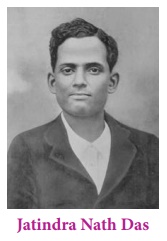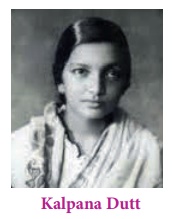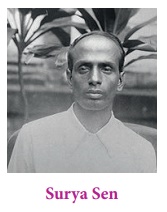Period of Radicalism in Anti-imperialist Struggles | History - Bhagat Singh and Kalpana Dutt | 12th History : Chapter 5 : Period of Radicalism in Anti-imperialist Struggles
Chapter: 12th History : Chapter 5 : Period of Radicalism in Anti-imperialist Struggles
Bhagat Singh and Kalpana Dutt
Bhagat Singh and Kalpana Dutt
Bhagat Singh’s Background
Bhagat
Singh represented a distinct strand of nationalism. His radical strand complemented,
in a unique way, to the overall ideals of the freedom movement.
“I began to study. My previous faith and convictions underwent a
remarkable modification. The romance of the violent methods alone which was so
prominent among our predecessors was replaced by serious ideas. No more
mysticism, no more blind faith. Realism became our cult. Use of force
justifiable when resorted to as a matter of terrible necessity: non-violence as
a policy indispensable for all mass movements. So much about methods. The most
important thing was the clear conception of the ideal for which we were to
fight….. from Bhagat Singh’s “Why I am an
Atheist”.
Bhagat
Singh was born to Kishan Singh (father) and Vidyavati Kaur (mother) on 28
September 1907 in Jaranwala, Lyallpur district, Punjab, now a part of Pakistan.
His father was a liberal and his family was a family of freedom fighters. The
Jallianwala Bagh massacre happened when Bhagat Singh was 14 years. Early in his
youth, he was associated with the Naujawan Bharat Sabha and the Hindustan
Republican Association. The latter organisation was founded by Sachin Sanyal
and Jogesh Chatterji. It was reorganised subsequently in September 1928 as the
Hindustan Socialist Republican Association (H.S.R.A) by Bhagat Singh and his
comrades. Socialist ideals and the October Revolution in Russia of 1917 were
large influences on these revolutionaries. Bhagat Singh was one of the leaders
of the H.S.R.A along with Chandrashekhar Azad, Shivaram Rajguru and Sukhdev
Thapar.
Bhagat Singh’s Bomb Throwing
The image
that comes to our mind at the very mention of Bhagat Singh’s name is that of
the bomb he threw in the Central Legislative Assembly on April 8, 1929. The
bombs did not kill anybody. It was intended as a demonstrative action, an act
of protest against the draconian laws of the British. They chose the day on
which the Trade Disputes Bill, an anti-labour legislation was introduced in the
assembly.
Lahore Conspiracy Case
Bhagat
Singh along with Rajguru, Sukhdev, Jatindra Nath Das and 21 others were arrested
and tried for the murder of Saunders (the case was known as the Second Lahore
Conspiracy Case). Jatindra Nath Das died in the jail after 64 days of hunger
strike against the discriminatory practices and poor conditions in jail. The
verdict in the bomb throwing case had been suspended until the trial of Lahore
Conspiracy trials was over. It was in this case that Bhagat Singh, Rajguru and
Sukhdev were sentenced to death on 7 October 1930.

A letter
from them to the Governor of Punjab shows their courage and their optimism over
the future of India even while facing death for the cause of freedom of their
country. It says, ‘the days of capitalism and imperialism are numbered. The war
neither began with us nor is going to end with our lives… According to the
verdict of your court we had waged a war and we are therefore war prisoners.
And we claim to be treated as such i.e., we claim to be shot dead instead of
being hanged.”
Some
narratives describe Bhagat Singh and his fellow patriots as terrorists. This is
a misconception. The legendary Bhagat Singh clarified how his group is
different from the terrorists. He said, during his trial, that revolution is
not just the cult of bomb and pistol…Revolution is the inalienable right of
mankind. Freedom is the imperishable birth-right of all. The labourer is the
real sustainer of society.. To the altar of this revolution we have brought our
youth as incense, for no sacrifice is too great for so magnificent a cause.’
Symbolically, they also shouted Inquilab
Zindabad after this defence statement
of his in the court.
Bhagat
Singh, Rajguru and Sukhdev were hanged early in the morning of March 23, 1931
in the Lahore Jail. They faced the gallows with courage, shouting Inquilab Zindabad and Down with British
Imperialism until their last breath. The history of freedom struggle is
incomplete without the revolutionary strand of nationalism and the ultimate
sacrifice of these revolutionaries. One more name in the list of such fighters
is Kalpana Dutt.
Kalpana Dutt (1913–1995)
In the
late 1920s a young woman, Kalpana Dutt (known as Kalpana Joshi after her
marriage to the communist leader P.C. Joshi), fired the patriotic imagination
of young people by her daring raid of the Chittagong armoury.
The H.S.R.A was a renewed chapter of the Hindustan Republican
Association. Its aim was the overthrow of the capitalist and imperialist
government and establish a socialist society through a revolution. The H.S.R.A
involved a number of actions such as the murder of Saunders in Lahore. In that,
Saunders was mistaken for the Superintendent of Police, Lahore, James A. Scott
who was responsible for seriously assaulting Lajpat Rai, in December 1928, and
Rai’s subsequent death. They also made an attempt to blow up the train in which
Lord Irwin (Governor General and Viceroy of India, 1926-1931) was travelling,
in December 1929, and a large number of such actions in Punjab and UP in 1930.

To understand the heroism of Kalpana Dutt, you
should understand the revolutionary strand of nationalism that attracted women
like her to these ideals. You have alreay learnt that there existed many
revolutionary groups in British India. The character of these organisations
gradually changed from being ones that practiced individual annihilation to
organising collective actions aimed at larger changes in the system.
As Surya Sen, the revolutionary leader of Chittagong armoury raid, told Ananda Gupta, ‘a dedicated band of youth must show the path of organised armed struggle in place of individual action. Most of us will have to die in the process but our sacrifice for such noble cause will not go in vain.’ When revolutionary groups like the Yugantar and the Anushilan Samiti began stagnating in the mid- 1920s, new groups sprang out of them. Among them, the most important group was the one led by Surya Sen, a school teacher by profession, in Bengal. He had actively participated in the Non-cooperation movement and wore Khadi. His group was closely working with the Chittagong unit of the Indian National Congress.
Chittagong Armoury Raid
Surya
Sen’s revolutionary group, the Indian Republican Army, was named after the
Irish Republican Army. They planned a rebellion to occupy Chittagong in a
guerrilla-style operation. The Chittagong armouries were raided on the night of
18 April 1930. Simultaneous attacks were launched on telegraph offices, the
armoury and the police barracks to cut off all communication networks including
the railways to isolate the region. It was aimed at challenging the colonial
administration directly.

The revolutionaries hoisted the national flag and symbolically shouted slogans such as Bande Matram and Inquilab Zindabad. The raids and the resistance continued for the next three years. Often, they operated from the villages and the villagers, gave food and shelter to the revolutionaries and suffered greatly at the hands of police for this. Due to the continuous nature of the actions, there was an Armoury Raid Supplementary Trial too. It took three years to arrest Surya Sen, in February 1933, and eleven months before he was sent to the gallows on 12 January 1934. Kalpana Dutt was among those who participated in the raids.
On 13 June 1932 in a face- to-face battle against government
forces, two of the absconders of the Armoury Raid were killed, while they in
turn killed Capt. Cameron, Commander of the government forces in the village of
Dhalghat in the house of a poor Brahmin widow, Savitri Debi. After the incident
the widow was arrested together with her children. Despite many offers and
temptations, not a word could the police get out of the widow. They were
uneducated and poor, yet they resisted all the temptation offers of gold and
unflinchingly could bear all the tortures that were inflicted upon them.
—From Kalpana Dutt’s autobiography Chittagong Armoury Raiders’ Reminiscences.
Women in Action
While
Bhagat Singh represented young men who dedicated their lives to the freedom of
the country, Kalpana Dutt represented the young women who defied the existing
patriarchal set up and took to arms for the liberation of their motherland. Not
only did they act as messengers (as elsewhere) but they also participated in
direct actions, fought along with men, carrying guns.
Kalpana
Dutt’s active participation in the revolutionary Chittagong movement led to her
arrest. Tried along with Surya Sen, Kalpana was sentenced to transportation for
life. The charge was “waging war against the King Emperor.” As all their
activities started with the raid on the Armoury, the trial came to be known as
the Chittagong Armoury Raid Trial.
Kalpana
Dutt recalls in her book Chittagong
Armoury Raiders Reminiscences the revolutionary
youth of Chittagong wanted “to inspire self-confidence by demonstrating that
even without outside help it was possible to fight the Government.
Related Topics